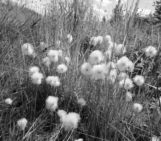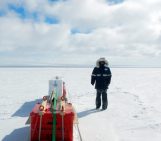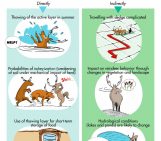
In this week’s blogpost, author, editor, artist, and outreach expert Marlo Garnsworthy gives some insights into her recent trip to Iceberg Alley, gives you some tips on how to communicate icy science, and shows us her inspirational artwork.
If you’re reading this, ice may be on your mind. Ice is surely on mine.
During my day job as a creative and editor, I dip frequently into Twitter for the latest cryosphere news. Memories of the Antarctic rumble like the thrusters of the research vessels I’ve called home: constant, comforting, and rising to a roar when I need stabilizing. Thoughts of polar science keep me steady and on course.
You may think scientists and creatives are very different. In fact, in the creative world, as in science, success comes with years spent developing wide-ranging technical and communication skills, less-than-stellar pay, so many rejections, and hard-won moments of joy. Both worlds require resiliency, a good attitude, and stamina. Incidentally, these experiences forge the soft skills we need for remote expeditions—we’re tough, don’t sweat the small stuff, and play nicely.
Going South
I first went south in 2017. I was invited by paleoceanographer Rebecca Robinson to sail on SNOWBIRDS Transect, studying diatoms and diatomaceous ooze, from McMurdo Station through the Southern Ocean. Seeing polar ice—from great grinding glaciers through the window of our Hercules LC-130, to the mosaic of melting summer sea ice in the Ross Sea, to massive icebergs drifting by—was transformative. I was in love with polar ice and with my Outreach role. I had to return.
So, I painted a LOT of polar scenes. I networked via social media and APECS workshops. I learned all I could about ice. I teamed up with my brilliant collaborator Kevin Pluck to form PixelMoversAndMakers.com.
And it all paid off.
I was invited to sail as Onboard Outreach Officer on the JOIDES Resolution, a drilling ship for the International Ocean Drilling Program. Expedition 382—Iceberg Alley took us to the iceberg-strewn Scotia Sea, where we cored millions of years of sediment. It will allow our team, led by Mike Weber and Maureen Raymo, to reconstruct past melting of the Antarctic Ice Sheet.
Of course, melting.
As I’ve gained more intimate knowledge of what is happening to our polar ice, making lasting changes to how I live has become my only moral choice. Not doing all I can to inform others has become unconscionable. I continue my work to connect a wide audience to the beauty and plight of our polar ice, always hoping I will return. Yet equally important to me is helping polar researchers better communicate their work.
Bringing the Poles to the People
We’re lucky that our science involves places of breathtaking beauty and harshness that most can only dream of seeing in person. It’s not difficult to engage people in the adventure. But conveying polar science comes with unique challenges because the subject of our work is so remote.
As an artist, I think, how can I show the subtle shifts in color, contrast, and texture of icy landscapes? The swiftly changing light, the sudden snow squalls, and the roaring of wind and waves—in a still image? The expanse of space and time in something that will fit on page or screen?
As a storyteller, how do I describe the sounds of a ship’s hull as it breaks sea ice? How it feels to live for months on a heaving surface? The thrill as icebergs pass by our vulnerable ship? The delight of breaching humpbacks and circling penguins? The boredom of eating cabbage at every meal? The bonds that form and the emotional costs of being far from home for months?
As a science communicator, I think, what do I want to say? What do I need to convey? Who is my audience? How do I show our scientific objectives in terms they can understand? How do I make grueling hours of lab- and fieldwork exciting and accessible? How can I most effectively use social media? How can I best speak to a crowd? How can I expand our audience?
Above all, how can I show why it all matters?
The public is becoming more aware of polar melting. But there’s a gaping crevasse between hearing something and really internalizing it. There’s a gulf between knowledge and action. Such leaps in consciousness and behavior can happen suddenly like an iceberg calving; more often, they happen as gradually as a glacier flows.
Telling a Story
Ultimately, it boils down to this: What can we make people feel? I believe effective science emotion turns facts (data) into “truth” (emotion) and that storytelling is our most powerful tool.
All good stories have a beginning, a middle, a climax, and a resolution. When I tell polar stories, I often aim to take people on this journey:
Beginning: Excitement & Wonder
Come on a faraway adventure: Glaciers! Icebergs! Vast icy vistas! Wild storms and massive seas… PENGUINS!
Middle: Interest & Awe
Whoa. That’s a WHOLE lot of ice. Here’s how we study it. Here’s why we study it.
Climax: Anxiety
Here’s how it feels. Yes, it’s melting. It might be far away, but it’s coming to a coastline near you…
Resolution: Hope & Motivation
But it’s not too late. There’s something we can do. Let’s get going! And…
PENGUINS!!!
(Always remember to include humor.)
What story will you tell?
Ice & Fire
On Wednesday 25th of September, the IPCC Special Report on the Ocean & Cryosphere in a Changing Climate (SROCC) was released. It’s unlikely to leave us feeling warm and fuzzy. But please let it fire up your passion to creatively share your science.
What skills can you offer? Do you enjoy photography? Making videos? Can you write a funny limerick or poignant haiku? Are you skilled with numbers or writing code? Are you good at building structures? At telling a story? At playing a musical instrument? At organizing things or people? Are you a social media whiz? (If not, it’s time to become one.) Your unique skills, whatever they may be, are waiting to be harnessed for creative sci-comm.
Speak simply. Speak the truth. Above all, speak your truth. Don’t be afraid to let your emotional connection to your work and polar regions show. And amplify others’ Outreach efforts, too. Together, we’re on the vanguard of this battle for awareness and action.

The interesting life found within the Antarctic inspires some of Marlo’s artwork [Credit: Marlo Garnsworthy].
Further links
- SNOWBIRDS Transect website
- Pixel Movers and Makers website
- Iceberg of Antarctica book (free download)
- Iceberg Alley and Subantarctic Ice and Ocean Dynamics project website
- Marlo’s website
Edited by Jenny Turton
 Marlo Garnsworthy is the author/illustrator of “Iceberg of Antarctica” (available as a free download) and several other books and is seeking her next polar adventure. Find her at www.WordyBirdStudio.com and PixelMoversAndMakers.com (with Kevin Pluck). Marlo tweets from @MarloWordyBird.
Marlo Garnsworthy is the author/illustrator of “Iceberg of Antarctica” (available as a free download) and several other books and is seeking her next polar adventure. Find her at www.WordyBirdStudio.com and PixelMoversAndMakers.com (with Kevin Pluck). Marlo tweets from @MarloWordyBird.





